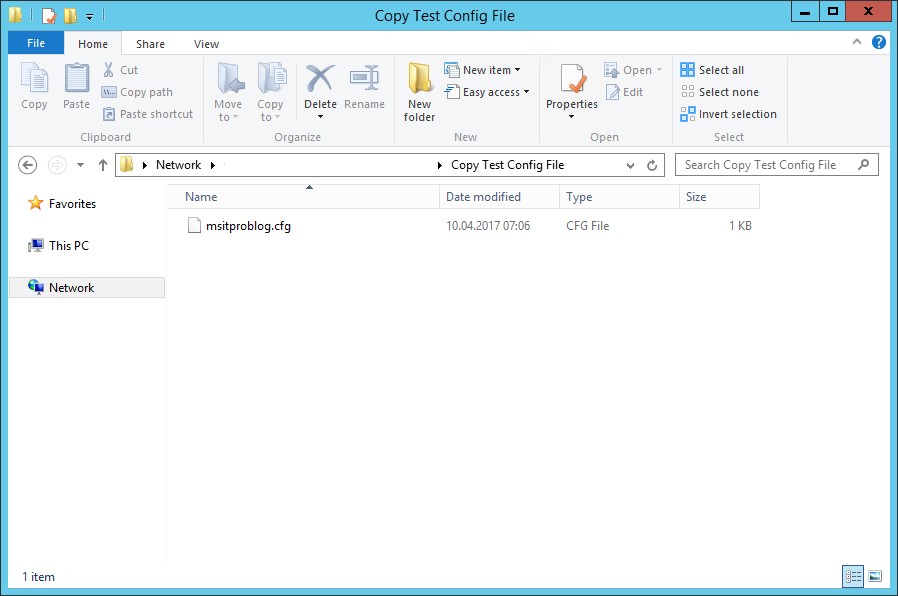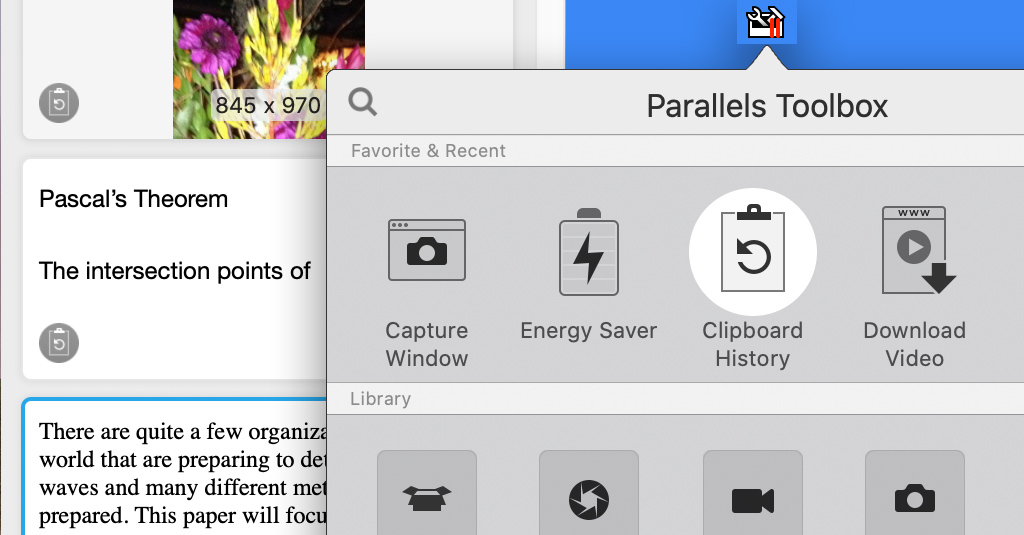Dedication: The clipboard is the unifying concept behind cut, copy, and paste. The individual responsible for cut, copy, and paste, Larry Tesler, passed away this month. Larry wrote the preface to my book, Object-Oriented Programming for the Macintosh, and was the person who hired me at Apple so many, many years ago. The computing world lost an important pioneer, and this blog post is dedicated to his memory. You can read more about Larry in The New York Times and the Washington Post.
The Clipboard History tool is one of the 30+ tools that are included in Parallels Toolbox. Try it for free: video shows the first o. See how it works in Video 5. Clipboard History also supports Universal Clipboard. This helpful combination makes it even easier to copy and paste anything (text, images, photos, and videos) across your Apple devices. So basically, you can copy a text on your iPhone and paste it later in another document on your Mac. Open Startup tab and look for prlcc.exe or Parallels Control Center. If prlcc.exe (or Parallels Control Center) is there, please make sure that it is running. Restart the virtual machine and check the issue. If it persists, please turn off User Account Control (UAC) and check again. The Clipboard History tool is one of the 30+ tools that are included in Parallels Toolbox. Try it for free: video shows the third o.
When it was first released in 1984, one of the defining features of the Macintosh user interface was the clipboard. The clipboard was great! You could copy any kind of data to it and then later paste that data into a new location. You could put text, graphics and entire documents or folders on the clipboard. Later on, you could put video clips, equations, spreadsheets and more on it. While the Mac was not the first computer with a clipboard—the Apple Lisa also had one—the Mac made the clipboard a widely known user interface (UI) concept.
There were, however, a couple of issues with the Mac clipboard. First, it only stored one piece of information at a time. Copy something else to the clipboard, and whatever was there before got removed. Second, it was invisible. The only way you could see what was on the clipboard was to paste the clipboard’s contents into a document. Lastly, the clipboard worked great on a single Mac, but there wasn’t any way to get the clipboard information to another Mac. Over the years, a variety of apps and extensions have tried to solve these issues, but none really caught on because none were as simple to use as the clipboard itself.
The Parallels engineers decided to solve these issues—the result is the new Clipboard History tool in Parallels® Toolbox for Mac. In this blog post, I’ll show you how to use this new tool. If you’re like me, you’ll find it so useful that you’ll set it to start up whenever you turn on your Mac.
The Clipboard History tool is one of forty tools in Parallels Toolbox for Mac (see Figure 1).
When running, it has a separate icon in the Mac menu bar—and when it’s open, its window shows you items that have been placed on the clipboard. (Figure 2)
Video 1 (3 minutes) introduces the Clipboard History tool and shows its use on a single Mac:
Video 2 (1 minute 30 seconds) shows how Apple’s Handoff works with the Clipboard History tool on two Mac devices.
Even though there is no Parallels Toolbox for the iPad, the Clipboard History tool can work with an iPad on the same network as your Mac. Video 3 (1 minute 30 seconds) shows an example of this:
I hope these examples show you the power of Parallels Toolbox. If you’re a subscriber of a recent version of Parallels Desktop™ for Mac, Parallels Toolbox is available to you at no charge. If you don’t have Parallels Desktop, you can download a free 7-day trial of Parallels Toolbox.
Taking a screenshot on a Mac® is as easy as on a PC—when you know the keyboard shortcuts to do so.
There are plenty of key commands in macOS® you might want to use for screen capture. Today, we’ll break down the six best shortcuts for screenshots that any Mac user NEEDS to know—plus the one useful application that accomplishes all that and more with just one click.
Capture a Screenshot of an Area
Figure 1 – Keyboard shortcut for taking a screenshot of part of a Mac screen
One of the most common needs for that “print screen” command on a Mac is when we need to capture a portion of the screen. It’s like a snipping tool for Mac. Be it an Instagram story, Twitter update, or part of a webpage to share with a colleague, you can screenshot any of those with just a few key combos.

(1) To capture a portion of the screen, do the following:
- Press Command-Shift-4 to change a pointer to a crosshair.
- Select the area of a screen you want to capture by moving and dragging the cursor.
- After releasing the mouse button, the screenshot will be saved as a PNG image on your desktop.
Figure 2 – Apple Support tweets the solution for screen capturing on Mac.
(2) To copy a portion of the screen to the clipboard, do the following:
- Press Command-Control-Shift-4 to change a pointer to a crosshair.
- Select the area of a screen you want to capture by moving and dragging the cursor.
- After clicking on the mouse, the screenshot will be saved to the clipboard.
- Select the application where you want to insert the captured image, such as Word, Skype, or Outlook.
- Press Command-V to paste the screenshot.
Capture a Screenshot of an Active Window
Figure 3 – The process of taking screenshots of an active application
If you need a screenshot of a specific application that you’re currently using, use this method. You can easily print screen an active window of any program, be it Safari, Chrome, Photoshop, or Microsoft Excel.
(3) To capture a screenshot of an active window, do the following:
- Press Command-Shift-4 to change a pointer to a crosshair.
- Tap on the spacebar on your keyboard. The cursor will change to a camera.
- Select the active application window you want to capture by moving your cursor.
- When you move the cursor over an application, the window will be highlighted.
- Click the mouse button on the window you want to capture. The screenshot will be saved as a PNG image on your desktop.
(4) To copy a screenshot of an active window to the clipboard, do the following:

- Press Command-Control-Shift-4 to change a pointer to a crosshair.
- Tap on the spacebar on your keyboard. The cursor will change to a camera.
- Select the active application window you want to capture by moving your cursor.
- When you move the cursor over an application, the window will be highlighted.
- Click the mouse button on the window you want to capture. The screenshot will be saved to the clipboard.
- Select the application where you want to insert the captured image, like Word, Skype, or Outlook
- Press Command-V to paste the screenshot.
Capture the Entire Screen

Figure 4 – Keyboard shortcut for capturing the entire screen on a Mac
(5) To capture a screenshot of a whole page, do the following:

- Press Command-Shift-3 to take a screenshot of the whole screen.
- The screenshot will be saved as a PNG image on your desktop.
(6) To copy a screenshot of a whole page to the clipboard, do the following:
- Press Command-Control-Shift-3 to copy the whole screen.
- The screenshot will be automatically saved to the clipboard.
- Select the application where you want to insert the captured image, like Word, Skype, or Outlook
- Press Command-V to paste the screenshot.
Mac App for Taking Screenshots
Figure 5 – Parallels Toolbox: The ultimate Mac application for screen and video capturing
Sometimes, remembering all the dozens of shortcuts to take a Mac screenshot is not our main priority. All we need is a simple application that has everything ready for us with just one click.
Parallels® Toolbox Screen and Video Pack is the best Designed to help optimize your workday, it has all the important tools for everyday needs, such as screen and video capturing, video converter, YouTube video downloader, and more.
You can try Parallels Toolbox without any obligations and decide for yourself whether a small introductory price is a fair cost for all the time saved.
Where to Find Screenshots on a Mac
Figure 6 – The primary location for all screenshots on a Mac is the desktop
Once you’re done taking them, where do screenshots on a Mac go?
Normally, screenshots are saved as PNG images (titled with the current date and time stamp) right on the desktop. The format looks as follows: “Screen Shot 2018-07-04 at 12.25.36.png”. Alternatively, a user can copy Mac screenshots to the clipboard by adding Control to the key combination and then pasting it right in the needed document. Here at Parallels, we practice this often—we love taking a MacBook® screenshot and sharing it with coworkers. It’s an easy and quick way to effectively communicate what we see on our end.
What to Do if Screen Capture on Mac Is Not Working

The shortcuts for screen capturing may not work for a few reasons. One of the most common ones: they are simply disabled.
To fix that, do the following:
Best Mac Clipboard Manager
- From the Apple menu in the top left corner, open System Preferences and click on the Keyboard.
- In the new window, click on Shortcuts.
- Find Screen Shots in the left menu.
- Check if the shortcuts are active and have the same key combos you type.
- To change a shortcut, select it and click the new key combination.
Clipboard Manager For Mac
If the shortcut is working but screenshots turn out blank, the reason is often copyright issues with the third-party application on the screen. To solve that, use the Parallels Toolbox application for screen capturing.